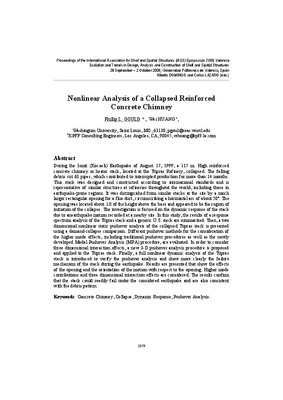JavaScript is disabled for your browser. Some features of this site may not work without it.
Buscar en RiuNet
Listar
Mi cuenta
Estadísticas
Ayuda RiuNet
Admin. UPV
Nonlinear analysis of a collapsed reinforced concrete chimney
Mostrar el registro completo del ítem
Gould, PL.; Huang, W. (2009). Nonlinear analysis of a collapsed reinforced concrete chimney. Editorial Universitat Politècnica de València. http://hdl.handle.net/10251/6647
Por favor, use este identificador para citar o enlazar este ítem: http://hdl.handle.net/10251/6647
Ficheros en el ítem
Metadatos del ítem
| Título: | Nonlinear analysis of a collapsed reinforced concrete chimney | |
| Autor: | GOULD, Phillip L. HUANG, Wei | |
| Editor: | ||
| Fecha difusión: |
|
|
| Resumen: |
During the Ismit (Kocaeli) Earthquake of August 17, 1999, a 115 m. High reinforced
concrete chimney or heater stack, located at the Tüpras Refinery, collapsed. The falling
debris cut 63 pipes, which contributed to ...[+]
|
|
| Palabras clave: |
|
|
| Derechos de uso: | Reserva de todos los derechos | |
| ISBN: |
|
|
| Fuente: |
|
|
| Editorial: |
|
|
| Título del congreso: |
|
|
| Lugar del congreso: |
|
|
| Fecha congreso: |
|
|
| Descripción: |
|
|
| Tipo: |
|







